Factors Influencing E-Shoppers Satisfaction in First Tier Cities of China
Added on 2022-11-18
67 Pages20565 Words268 Views
Running head: E-COMMERCE SHOPPING
The Topic: The empirical study of factors that influence online E-shoppers satisfaction in the first
tier cities of China
Name of the Student
Name of the University
Author Note
The Topic: The empirical study of factors that influence online E-shoppers satisfaction in the first
tier cities of China
Name of the Student
Name of the University
Author Note
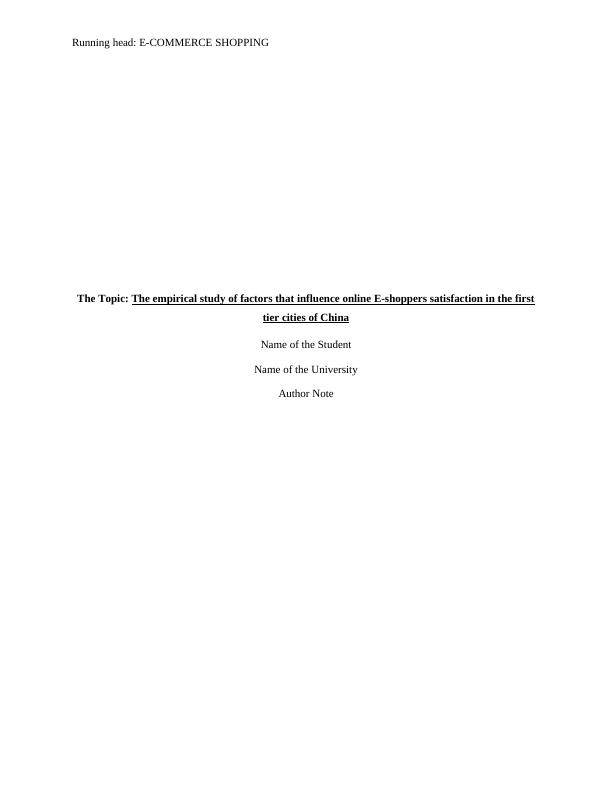
E-COMMERCE SHOPPING1
Executive Summary
The e-commerce shopping has become considerably popular and hence, this reading aims to capture the
essence of e-commerce shopping in China. It intended to determine how the e-commerce shopping has
the tendency to influence the different customers and provide adequate satisfaction to them. The study
followed a comprehensive format whereby the Introduction provided an overall background of the study
which was tailed by the Review of Literature. The review presented a thorough outline of the manner in
which the theoretical frameworks determine the factors impacting the overall customer convenience and
satisfaction. The research methodology presented an analysis of the way in which the research procedures
have been outlined in order to find the outcome of the study. The findings and the analysis of the study
were conducted and have been presented in the form of graphs and other such pictorial presentations. The
analysis of this findings was presented and this was followed by the last chapter which summarized the
study, linked it to the objectives and the provided a brief recommendations which could be followed by
the firms in China.
Executive Summary
The e-commerce shopping has become considerably popular and hence, this reading aims to capture the
essence of e-commerce shopping in China. It intended to determine how the e-commerce shopping has
the tendency to influence the different customers and provide adequate satisfaction to them. The study
followed a comprehensive format whereby the Introduction provided an overall background of the study
which was tailed by the Review of Literature. The review presented a thorough outline of the manner in
which the theoretical frameworks determine the factors impacting the overall customer convenience and
satisfaction. The research methodology presented an analysis of the way in which the research procedures
have been outlined in order to find the outcome of the study. The findings and the analysis of the study
were conducted and have been presented in the form of graphs and other such pictorial presentations. The
analysis of this findings was presented and this was followed by the last chapter which summarized the
study, linked it to the objectives and the provided a brief recommendations which could be followed by
the firms in China.
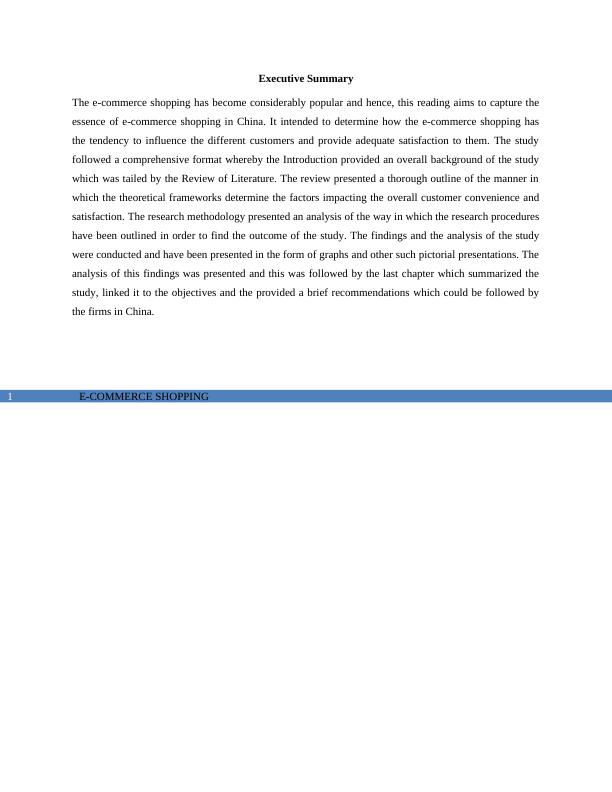
E-COMMERCE SHOPPING2
Table of Contents
Chapter 1: Introduction................................................................................................................................5
1.1 Overview...........................................................................................................................................5
1.2 Problem statement.............................................................................................................................6
1.3 Research aim.....................................................................................................................................7
1.4 Research Objectives...........................................................................................................................7
1.5 Research Questions............................................................................................................................8
1.6 Research Hypothesis..........................................................................................................................8
1.7 Research Rationale............................................................................................................................9
1.8 Structure of the Paper........................................................................................................................9
Chapter 2: Literature Review.....................................................................................................................10
2.1 Overview.........................................................................................................................................10
2.2 E-commerce shopping.....................................................................................................................10
2.3 Factors affecting online shopping of customers...............................................................................11
2.4 Customer satisfaction.......................................................................................................................14
2.5 Factors influencing Customer satisfaction.......................................................................................15
2.6 Conceptual Framework....................................................................................................................19
2.7 Literature Gap..................................................................................................................................19
2.8 Summary.........................................................................................................................................20
Chapter 3: Research Methodology.............................................................................................................21
3.1 Overview.........................................................................................................................................21
3.2 Research outline..............................................................................................................................21
3.3 Research philosophy........................................................................................................................21
Explanation of the research philosophy.................................................................................................22
3.4 Research approach...........................................................................................................................22
Explanation for the research approach...................................................................................................22
Table of Contents
Chapter 1: Introduction................................................................................................................................5
1.1 Overview...........................................................................................................................................5
1.2 Problem statement.............................................................................................................................6
1.3 Research aim.....................................................................................................................................7
1.4 Research Objectives...........................................................................................................................7
1.5 Research Questions............................................................................................................................8
1.6 Research Hypothesis..........................................................................................................................8
1.7 Research Rationale............................................................................................................................9
1.8 Structure of the Paper........................................................................................................................9
Chapter 2: Literature Review.....................................................................................................................10
2.1 Overview.........................................................................................................................................10
2.2 E-commerce shopping.....................................................................................................................10
2.3 Factors affecting online shopping of customers...............................................................................11
2.4 Customer satisfaction.......................................................................................................................14
2.5 Factors influencing Customer satisfaction.......................................................................................15
2.6 Conceptual Framework....................................................................................................................19
2.7 Literature Gap..................................................................................................................................19
2.8 Summary.........................................................................................................................................20
Chapter 3: Research Methodology.............................................................................................................21
3.1 Overview.........................................................................................................................................21
3.2 Research outline..............................................................................................................................21
3.3 Research philosophy........................................................................................................................21
Explanation of the research philosophy.................................................................................................22
3.4 Research approach...........................................................................................................................22
Explanation for the research approach...................................................................................................22
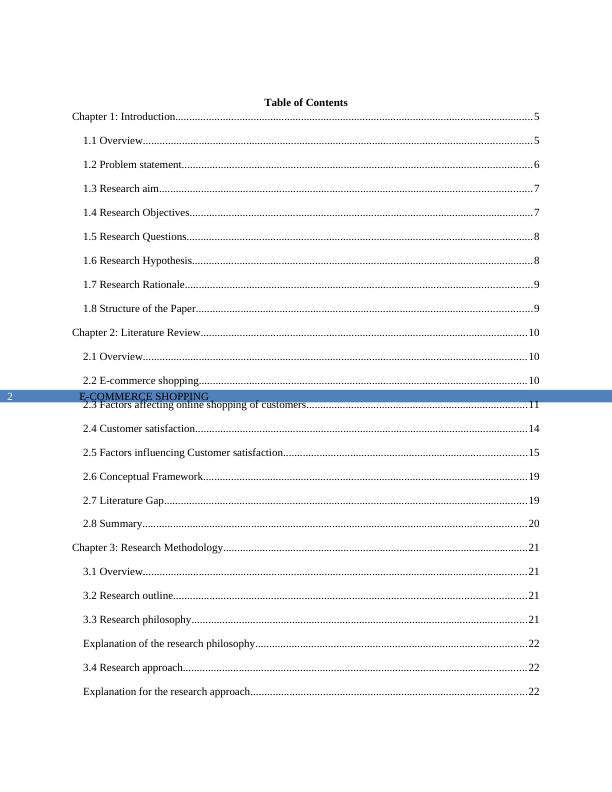
E-COMMERCE SHOPPING3
3.5 Research design...............................................................................................................................22
Explanation for the research design.......................................................................................................23
3.6 Research strategy.................................................................................................................................23
Explanation for the research strategy embraced.....................................................................................23
3.7 Sampling procedures.......................................................................................................................23
Explanation for the sampling procedure................................................................................................24
3.8 Data collection method....................................................................................................................25
Explanation for the data collection method............................................................................................25
3.9 Data analysis Method......................................................................................................................25
Explanation for the data analysis method..............................................................................................26
3.10 Ethical considerations........................................................................................................................26
3.11 Accessibility issues........................................................................................................................26
3.12 Summary.......................................................................................................................................27
Chapter 4: Findings...................................................................................................................................28
4.1 Overview.........................................................................................................................................28
4.2 Descriptive Statistics.......................................................................................................................28
4.3 Inferential Statistics.........................................................................................................................34
Correlation Analysis..............................................................................................................................34
Regression Analysis..............................................................................................................................42
Factor Analysis......................................................................................................................................46
4.4 Hypothesis.......................................................................................................................................49
Chapter 5: Analysis and Results................................................................................................................50
5.1 Overview.........................................................................................................................................50
5.2 Analysis of Findings........................................................................................................................50
5.3 Discussion.......................................................................................................................................51
5.4 Summary.........................................................................................................................................53
Chapter 6: Conclusion...............................................................................................................................54
3.5 Research design...............................................................................................................................22
Explanation for the research design.......................................................................................................23
3.6 Research strategy.................................................................................................................................23
Explanation for the research strategy embraced.....................................................................................23
3.7 Sampling procedures.......................................................................................................................23
Explanation for the sampling procedure................................................................................................24
3.8 Data collection method....................................................................................................................25
Explanation for the data collection method............................................................................................25
3.9 Data analysis Method......................................................................................................................25
Explanation for the data analysis method..............................................................................................26
3.10 Ethical considerations........................................................................................................................26
3.11 Accessibility issues........................................................................................................................26
3.12 Summary.......................................................................................................................................27
Chapter 4: Findings...................................................................................................................................28
4.1 Overview.........................................................................................................................................28
4.2 Descriptive Statistics.......................................................................................................................28
4.3 Inferential Statistics.........................................................................................................................34
Correlation Analysis..............................................................................................................................34
Regression Analysis..............................................................................................................................42
Factor Analysis......................................................................................................................................46
4.4 Hypothesis.......................................................................................................................................49
Chapter 5: Analysis and Results................................................................................................................50
5.1 Overview.........................................................................................................................................50
5.2 Analysis of Findings........................................................................................................................50
5.3 Discussion.......................................................................................................................................51
5.4 Summary.........................................................................................................................................53
Chapter 6: Conclusion...............................................................................................................................54
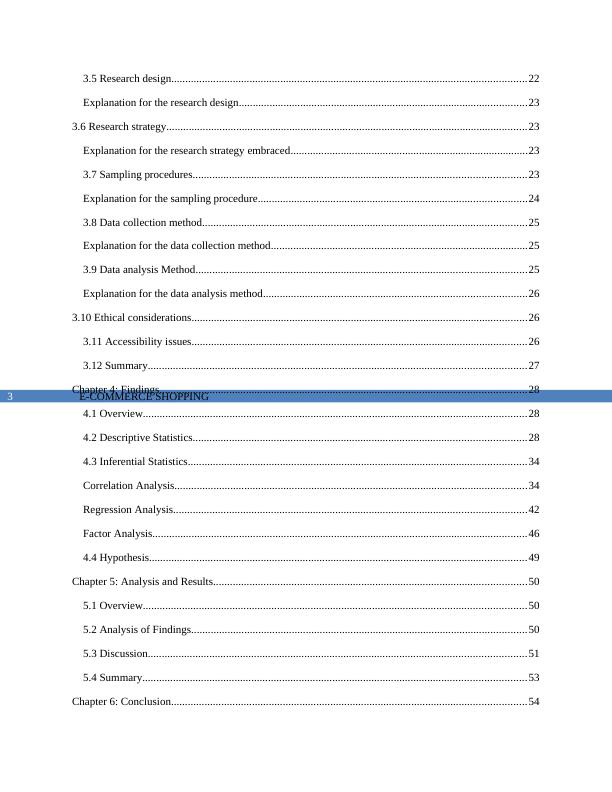
E-COMMERCE SHOPPING4
6.1 Overview.........................................................................................................................................54
6.2 Linking to Objectives......................................................................................................................55
6.3 Limitations of the study...................................................................................................................55
6.4 Future scope.....................................................................................................................................56
6.5 Recommendations...........................................................................................................................56
References.................................................................................................................................................57
Appendix...................................................................................................................................................61
Questionnaire.........................................................................................................................................61
6.1 Overview.........................................................................................................................................54
6.2 Linking to Objectives......................................................................................................................55
6.3 Limitations of the study...................................................................................................................55
6.4 Future scope.....................................................................................................................................56
6.5 Recommendations...........................................................................................................................56
References.................................................................................................................................................57
Appendix...................................................................................................................................................61
Questionnaire.........................................................................................................................................61

E-COMMERCE SHOPPING5
Chapter 1: Introduction
1.1 Overview
The Chinese consumer trend index has stabilized considerable in the year 2018. In relation to this,
during the third quarter of the same year, the consumer trend index was 113 points which was similar to
that of last year however, more than the global average of the 105. As the overall economic structure of
the country has been maximizing considerably, the economic growth is continuing to grow and this
makes it important that the economic operations can be essentially maintained at a reasonable range. The
National Bureau of Statistics stated that, the consumer contribution rate of interest has also been
increasing considerable and was at 78% in the year 2018 which was a 13.8% increase as compared to the
previous year. Hence, from this, it can be essentially recognized that the consumption oriented role of the
consumer has become protuberant and such a trend which is indicating rapid growth, consumption and as
well as purchases indicates that the consumption structure is upgrading.
The role of consumption is becoming increasingly crucial with the development stage of China
increasing at a considerable rate. The FMCG market has maintained its strong position and is strong in
2018 with progress rate of 14% which is a 5% growth since in 2017. According to Ren et al. (2016), in
this scenario, the Product innovation, physical store growth and the consumption upgrades can be
recognized to be the main drivers of the FMCG products. In regard to this, the contribution of the new
artefact sales to the offline profligate moving goods evolution can be recognized to be as high as 41% and
hence, with considerable advancements of the supply side organizational reform and the application of the
invention driven strategies, stamina and vitality of the consumer innovation shall continue to release
considerably.
Ramanathan, Subramanian and Parrott (2017), states that the Consumption upgrade can be reflected
to be an indication of the people`s quest for a better life and the consumer upgradation stands as the core
growth driver at 84% of the FMCG product. In the same time frame, the growth of the physical stores for
the overall brand has reached 10% and on the other side the e-commerce book which indicates the growth
of the online sales indicates a growth of 32%. However, as the business environment has advanced
considerably, the four driving factors have become considerably complicated in nature and in line of this,
although the products remain a considerably focused growth driver, the new category products
approximating to 50% of the new products have experienced decreased sales and this is inclusive of the
70% of the fast moving goods as well. Although the development and growth of the physical stores has
remained considerably stable and that 43% of the stores were replaced as well as iterated, it is crucial to
note that, the rapid development of the ecommerce has attracted more types of ecommerce businesses to
Chapter 1: Introduction
1.1 Overview
The Chinese consumer trend index has stabilized considerable in the year 2018. In relation to this,
during the third quarter of the same year, the consumer trend index was 113 points which was similar to
that of last year however, more than the global average of the 105. As the overall economic structure of
the country has been maximizing considerably, the economic growth is continuing to grow and this
makes it important that the economic operations can be essentially maintained at a reasonable range. The
National Bureau of Statistics stated that, the consumer contribution rate of interest has also been
increasing considerable and was at 78% in the year 2018 which was a 13.8% increase as compared to the
previous year. Hence, from this, it can be essentially recognized that the consumption oriented role of the
consumer has become protuberant and such a trend which is indicating rapid growth, consumption and as
well as purchases indicates that the consumption structure is upgrading.
The role of consumption is becoming increasingly crucial with the development stage of China
increasing at a considerable rate. The FMCG market has maintained its strong position and is strong in
2018 with progress rate of 14% which is a 5% growth since in 2017. According to Ren et al. (2016), in
this scenario, the Product innovation, physical store growth and the consumption upgrades can be
recognized to be the main drivers of the FMCG products. In regard to this, the contribution of the new
artefact sales to the offline profligate moving goods evolution can be recognized to be as high as 41% and
hence, with considerable advancements of the supply side organizational reform and the application of the
invention driven strategies, stamina and vitality of the consumer innovation shall continue to release
considerably.
Ramanathan, Subramanian and Parrott (2017), states that the Consumption upgrade can be reflected
to be an indication of the people`s quest for a better life and the consumer upgradation stands as the core
growth driver at 84% of the FMCG product. In the same time frame, the growth of the physical stores for
the overall brand has reached 10% and on the other side the e-commerce book which indicates the growth
of the online sales indicates a growth of 32%. However, as the business environment has advanced
considerably, the four driving factors have become considerably complicated in nature and in line of this,
although the products remain a considerably focused growth driver, the new category products
approximating to 50% of the new products have experienced decreased sales and this is inclusive of the
70% of the fast moving goods as well. Although the development and growth of the physical stores has
remained considerably stable and that 43% of the stores were replaced as well as iterated, it is crucial to
note that, the rapid development of the ecommerce has attracted more types of ecommerce businesses to
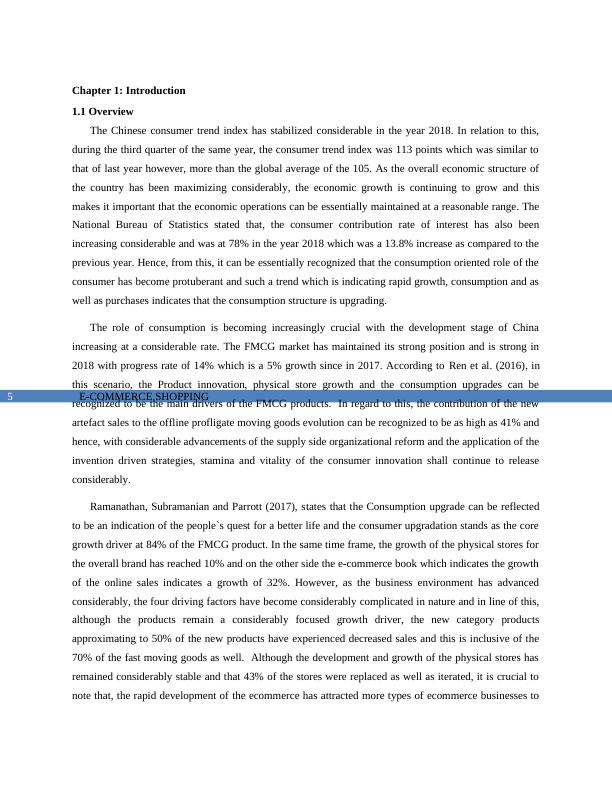
E-COMMERCE SHOPPING6
compete accordingly and this has also lead to the involvement of the nonintegrated e-commerce users.
The e-commerce field has practiced a considerable growth rate of 194% whereas the monthly users has
increased by 22% only (Amin 2016). However, in a complex environment which is diverse in nature, it
becomes critically crucial for the business to comprehend the various trends relating to the complex and
diverse consumer environment and the trends of the people, good and fields through the medium of data
analysis is required to be recognized so as to predict the upcoming trends in the year 2019 and in line of
this driving the business and related marketing innovation.
Therefore, by gaining these insights, the brands will be able to perform in a better manner. Therefore,
this research can be recognized to be focused at the manner in which the E-commerce customer
satisfaction can take place adequately in the first tier cities in China and how the different organizations
will be able to focus on providing brand value to the different customers as present.
1.2 Problem statement
The modernization of life has made the individuals very busy and it is in regard to this that, the
medium of Internet shopping has become considerably popular and can be easily browsed and accessed
also. The most convenient aspect of the Internet shopping can be considered to be the fact that, Internet
shopping allows the different users to shop from the convenience of their homes or offices or for that
matter from any point where the network connectivity is available for the user. Not only do these online
websites allow the users with a greater variety, but also allow the different users with considerable
discounts. Therefore, due to these various advantages being offered by the particular online domain, many
students, house wife’s, office workers and other personnel like to shop online.
In contrary to this, there are considerable risks involved in the particular field of shopping which
generally tends to come in the form of the payment to be made, the quality of the items to be provided,
the delivery and other such contrary risks as present in the field. Various online sellers often tend to claim
that there exists a considerable gap between the products which are exhibited on the internet and the
beings as received by the various customers (Izogo and Ogba 2015). The origin, date of manufacturing
and other related information also tends to differ. Very often after the payment has been made, the seller
does not receive the product and has nowhere to go and therefore in such a case, there can be recognized
to be various fraudulent cases which have taken place in the particular domain. Hence, the different
online shoppers will be required to certify that they are conscious of the perils of online shopping before
they proceed with it. The e-shoppers will be required to select an excellent shopping platform and
comprehend all the existing policies which exist in such a domain. In addition to this, the evaluation of
the buyer needs to be done and in addition to this, the satisfaction level of the seller also needs to be
recognized considerably. Moreover, it is the duty of the buyer that before purchasing the product they are
compete accordingly and this has also lead to the involvement of the nonintegrated e-commerce users.
The e-commerce field has practiced a considerable growth rate of 194% whereas the monthly users has
increased by 22% only (Amin 2016). However, in a complex environment which is diverse in nature, it
becomes critically crucial for the business to comprehend the various trends relating to the complex and
diverse consumer environment and the trends of the people, good and fields through the medium of data
analysis is required to be recognized so as to predict the upcoming trends in the year 2019 and in line of
this driving the business and related marketing innovation.
Therefore, by gaining these insights, the brands will be able to perform in a better manner. Therefore,
this research can be recognized to be focused at the manner in which the E-commerce customer
satisfaction can take place adequately in the first tier cities in China and how the different organizations
will be able to focus on providing brand value to the different customers as present.
1.2 Problem statement
The modernization of life has made the individuals very busy and it is in regard to this that, the
medium of Internet shopping has become considerably popular and can be easily browsed and accessed
also. The most convenient aspect of the Internet shopping can be considered to be the fact that, Internet
shopping allows the different users to shop from the convenience of their homes or offices or for that
matter from any point where the network connectivity is available for the user. Not only do these online
websites allow the users with a greater variety, but also allow the different users with considerable
discounts. Therefore, due to these various advantages being offered by the particular online domain, many
students, house wife’s, office workers and other personnel like to shop online.
In contrary to this, there are considerable risks involved in the particular field of shopping which
generally tends to come in the form of the payment to be made, the quality of the items to be provided,
the delivery and other such contrary risks as present in the field. Various online sellers often tend to claim
that there exists a considerable gap between the products which are exhibited on the internet and the
beings as received by the various customers (Izogo and Ogba 2015). The origin, date of manufacturing
and other related information also tends to differ. Very often after the payment has been made, the seller
does not receive the product and has nowhere to go and therefore in such a case, there can be recognized
to be various fraudulent cases which have taken place in the particular domain. Hence, the different
online shoppers will be required to certify that they are conscious of the perils of online shopping before
they proceed with it. The e-shoppers will be required to select an excellent shopping platform and
comprehend all the existing policies which exist in such a domain. In addition to this, the evaluation of
the buyer needs to be done and in addition to this, the satisfaction level of the seller also needs to be
recognized considerably. Moreover, it is the duty of the buyer that before purchasing the product they are

E-COMMERCE SHOPPING7
being able to observe the internet and take decisions accordingly. This saves the buyer from any kind of a
disappointment which might take place and hence, the customer as well as the seller would not be
required to go under any harassment or state that they are being subjected to a kind of inconvenience as
present.
According to Pizam, Shapoval and Ellis (2016), a study by the University of Bamberg reflects that in
the fashion sector more than half of the products which are purchased online are generally returned.
Moreover, this trend has been able to gain considerable popularity back in China and therefore, the
problem which needs to be analyzed as well as identified in the particular domain can be recognized to be
related to the problem of the customer satisfaction of the E-shoppers in the first tier cities of China. These
cities are the Beijing, Shanghai, Guangzhou, Tianjin and the Chongqing. There are various aspects of the
online shopping which may either satisfy the customers or cause them considerable dissatisfaction and it
is in regard to this that, comprehending the factors which contribute to the satisfaction of the different
customers in China is an aspect which becomes judgmentally vital to comprehend. Moreover, once the
comprehending of these factors can be undertaken, certain commendations to progress the complete setup
can also be provided essentially.
1.3 Research aim
From the point of view of a investigator, it becomes essentially crucial for all the businesses as
present to comprehend which factors tend to influence the E-shoppers as present in the first tier cities of
China like the Beijing, Shanghai, Guangzhou, Tianjin and the Chongqing and in regard to this, it also
becomes very vital for the companies to certify that, they are competent to find out the problem which
exists, and are able to provide a solution that will help the E-commerce business to perform well. The
identification of the dependent and the independent variable in such a scenario can be considered crucial
to comprehend because it tends to serve as an essential source factor to condition the market in a well-
defined manner. In addition to this, it shall allow the e-shoppers to comprehend and receive better service
from the side of the different sellers as present.
1.4 Research Objectives
The research objectives for the paper intends to fulfill and attain can be recognized to be as follows:
I. The objective is to analyze the substantial affiliation of Price factor & convenience and E-
shoppers’ satisfaction in the first tier cities of China.
II. The objective is to analyze the substantial affiliation of website design, features & perceived risk
and E-shoppers’ satisfaction in the first tier cities of China.
being able to observe the internet and take decisions accordingly. This saves the buyer from any kind of a
disappointment which might take place and hence, the customer as well as the seller would not be
required to go under any harassment or state that they are being subjected to a kind of inconvenience as
present.
According to Pizam, Shapoval and Ellis (2016), a study by the University of Bamberg reflects that in
the fashion sector more than half of the products which are purchased online are generally returned.
Moreover, this trend has been able to gain considerable popularity back in China and therefore, the
problem which needs to be analyzed as well as identified in the particular domain can be recognized to be
related to the problem of the customer satisfaction of the E-shoppers in the first tier cities of China. These
cities are the Beijing, Shanghai, Guangzhou, Tianjin and the Chongqing. There are various aspects of the
online shopping which may either satisfy the customers or cause them considerable dissatisfaction and it
is in regard to this that, comprehending the factors which contribute to the satisfaction of the different
customers in China is an aspect which becomes judgmentally vital to comprehend. Moreover, once the
comprehending of these factors can be undertaken, certain commendations to progress the complete setup
can also be provided essentially.
1.3 Research aim
From the point of view of a investigator, it becomes essentially crucial for all the businesses as
present to comprehend which factors tend to influence the E-shoppers as present in the first tier cities of
China like the Beijing, Shanghai, Guangzhou, Tianjin and the Chongqing and in regard to this, it also
becomes very vital for the companies to certify that, they are competent to find out the problem which
exists, and are able to provide a solution that will help the E-commerce business to perform well. The
identification of the dependent and the independent variable in such a scenario can be considered crucial
to comprehend because it tends to serve as an essential source factor to condition the market in a well-
defined manner. In addition to this, it shall allow the e-shoppers to comprehend and receive better service
from the side of the different sellers as present.
1.4 Research Objectives
The research objectives for the paper intends to fulfill and attain can be recognized to be as follows:
I. The objective is to analyze the substantial affiliation of Price factor & convenience and E-
shoppers’ satisfaction in the first tier cities of China.
II. The objective is to analyze the substantial affiliation of website design, features & perceived risk
and E-shoppers’ satisfaction in the first tier cities of China.
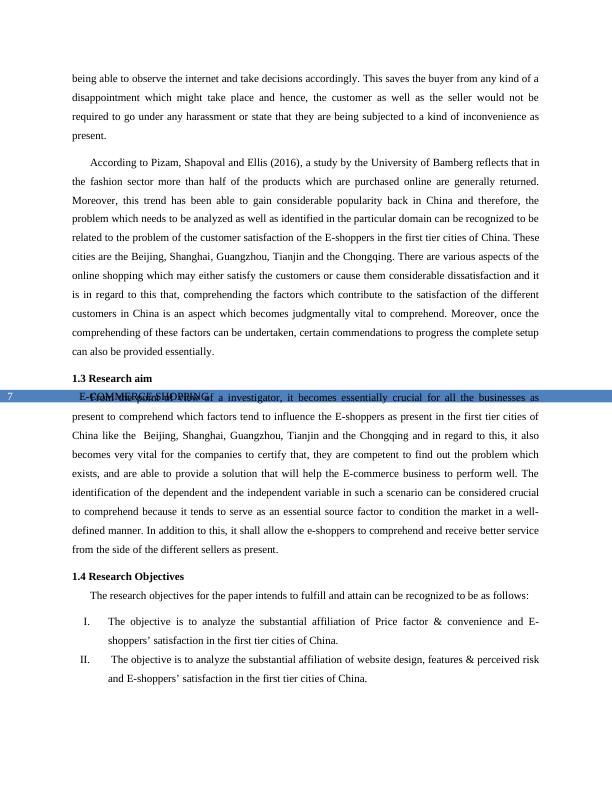
End of preview
Want to access all the pages? Upload your documents or become a member.
Related Documents
XXX in China: Marketing Strategies for Expansionlg...
|68
|16736
|25
Influences of Digital Economy on E-commerce in Malaysialg...
|102
|17600
|284
MANAGEMENT. Management Name of the Student Name of thelg...
|62
|13304
|353
Topic: An Investigation into Threat Modelling Tools and Technique Used in Securing E-Commerce Applications Onlinelg...
|84
|20598
|225
Impulsive Buying Behavior Research Report 2022lg...
|88
|19870
|6
Impact of social media on customer satisfaction Case Study 2022lg...
|64
|19508
|14